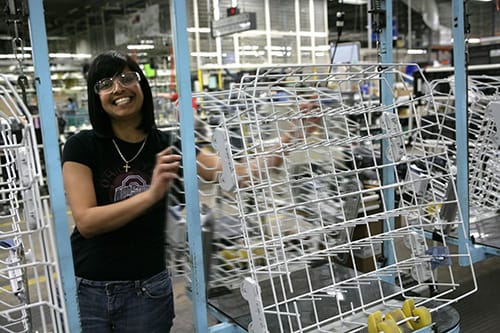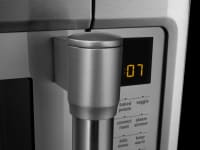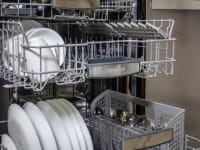Ask the Experts: Why don’t new home appliances last?
It's true: They don't make 'em like they used to.
 Credit:
Reviewed.com / Johnny Yu
Credit:
Reviewed.com / Johnny Yu
Recommendations are independently chosen by Reviewed's editors. Purchases made through the links below may earn us and our publishing partners a commission.
At Reviewed, our team of expert reviewers has a wealth of knowledge that you can lean on. If you have a question about electronics, appliances, or virtually anything else you can buy, send an email to request@reviewed.com. We can’t answer your etiquette questions or help you find love, but we can make you a more educated consumer.
This week, Reviewed's appliance experts answer questions from readers who want to dig a little bit deeper. We find out which dishwashers are made in the USA, as well as figure out how long major appliances are supposed to last.
The answers may surprise you, so stick around as we dish some dirt on dishwashers.
Where is it made?
Evans asks:
“On your dishwasher reviews, how many are made in the United States?”
Great question. As it turns out, most dishwashers sold in the U.S. are made in the U.S.
Whirlpool, Maytag, Amana, KitchenAid, and IKEA dishwashers are made at the world’s largest dishwasher factory, located in Findlay, Ohio. And the facility is getting even bigger—it's currently in the middle of a $40.6 million expansion.

Whirlpool just announced a major investment in its Findlay, Ohio, factory. Shown here is a Findlay employee holding dishwasher racks.
Frigidaire’s plastic-tub dishwashers are built in Kinston, North Carolina, and most GE dishwashers come from the company’s landmark Appliance Park facility in Louisville, Kentucky. Even though Bosch is best known for its German heritage, the majority of its 24-inch dishwashers sold in the U.S. (plus a few Thermador models) are made in New Bern, North Carolina.
{{ amazon name="SPT Countertop Dishwasher", asin="B004MX8XO6", align="right" }} Many other European brands build their dishwashers in Europe. For instance, Miele dishwashers—and many of the components that go into them—are made in Bielefeld, Germany. Flush-install Gaggenau, Jenn-Air, Thermador, Bosch Benchmark, and Bosch 18-inch dishwashers are made in Dillingen, Germany, while high-end Electrolux and Frigidaire dishwashers are built in Solaro, Italy.
The majority of LG and Samsung dishwashers are built in Korea. Blomberg (which builds dishwashers under the Summit, Beko, and Viking brand names) has an all-inclusive factory outside Istanbul, Turkey. Asko dishwashers are built in Velenje, Slovenia.
Most portable models are made in China, as are models from Haier, Fagor, and Bertazzoni.
They really don’t make them like they used to
Sheralyn asks:
“I am shopping for a washer, dryer and dishwasher. I have spoken with several appliance repair people and all tell me the lifespan of most appliances built today averages 4 years. Do you offer cycle ratings on washers and information on dryers and dishwashers with regard to lifespan? Also, do you provide any information on average repair costs, especially for newer tech-heavy appliances?”
The lifespan of most appliances built today is indeed shorter than it was decades ago, but it’s not as short as four years.
The most reliable data comes from a survey the National Association of Homebuilders, conducted back in 2007. It found that the average major appliance lasts fewer than 15 years. Dishwashers last about nine years, washers and dryers about 10, and refrigerators about 13.
In addition to broad economic factors that affect all durable goods, appliance lifespans are shorter for a few specific reasons. The first is that production of individual components is frequently outsourced to the least-expensive third-party manufacturers. Additionally, both finished products and their components are designed to weigh less, so that they’re less expensive for manufacturers to ship. Finally, tolerances are tighter, fits are closer, and electronic controls have taken the place of mechanical ones—in other words, more plastic and less metal.
In fact, appliance lifespans have gradually decreased over the years. Since most consumers don’t buy appliances very often, however, the effect seems more dramatic when a dishwasher breaks down after just 10 years even though it replaced a model that lasted 30.
It’s extremely difficult to estimate the reliability of an individual model. Brands use multiple factories and suppliers for single product lines, so a Kenmore oven from 2008 may have been built in a totally different factory—and, potentially, a totally different country—than one produced in 2015. Individual product components are sourced from multiple suppliers over time, so a dishwasher built in 2009 may have a different pump than the same model built in 2013.
{{ amazon name="Troubleshooting and Repairing Major Appliances", asin="0071770186", align="right" }} With that said, user reviews for a particular product—or one similar to it—can be a helpful tool to determine if you’re at risk of getting a lemon. For instance, it would be smart to avoid a product with 50 or more negative reviews that all mention the same flaw.
There's a silver lining, too: Today’s appliances are far more affordable than ever before. The American Enterprise Institute, a conservative think tank, published a study showing the average home appliance is three times more affordable than it was in 1981.
Put another way, if it cost you a full paycheck to buy a new appliance in 1981, an equivalent model would only cost a third of your paycheck today. That’s not even accounting for the significant energy savings a modern appliance offers over its predecessor—as much as $700 over the lifetime of a modern fridge compared to a refrigerator from 1981.

Speed Queen makes commercial laundry equipment designed for heavy use. The company uses the same components in its consumer machines, which makes it popular with customers looking for a heavy-duty washer and dryer.
And while today’s mass-market appliances aren’t as durable as their predecessors, that doesn’t mean you can’t shop like it’s 1965. Just as it’s possible to recapture the glamor of traveling in the golden age of aviation by paying for a first class ticket, you can buy a modern appliance with good, old-fashioned build quality.
Companies like Miele, Wolf, Sub-Zero, and Speed Queen build heavy-duty products that are designed to last longer than what you can buy at a big box store. The trade-off is that their appliances tend to cost significantly more than the competition.



